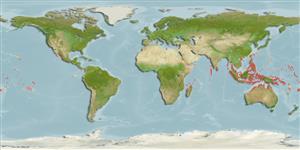>
Gobiiformes (Gobies) >
Oxudercidae (Mudskippers) > Periophthalminae
Etymology: Periophthalmus: Greek, peri = around + Greek, ophthalmos = eye (Ref. 45335).
Environment: milieu / climate zone / depth range / distribution range
Écologie
marin; saumâtre récifal; profondeur 0 - 2 m. Tropical; 30°N - 20°S
Indo-Pacific: East Africa to Samoa.
Taille / Poids / Âge
Maturity: Lm ? range ? - ? cm
Max length : 14.1 cm SL mâle / non sexé; (Ref. 7050)
Description synthétique
Clés d'identification | Morphologie | Morphométrie
Épines dorsales (Total) : 8 - 16; Rayons mous dorsaux (Total) : 10 - 12; Épines anales: 1; Rayons mous anaux: 9 - 11. Differs from P. argentilineatus by lacking thin silvery bars ventrally on the sides and having pelvic fins connected at the base by a low membrane (Ref. 37816); further characterized by: frenum of pelvic fins vestigial, but visible macroscopically; pelvic fins united by membrane for about one half their length; D1 height moderate, its margin rounded, black stripe inframarginally with numerous white spots proximally, no elongate spines; D2 with single dusky stripe inframarginally; dorsal fins not connected by membrane; D1 with 11-15 spines; longitudinal scale count 66-86; head width 16.5-22.5% SL; pelvic fin length 13.1-15.4% SL; length of anal fin base 15.9-18.7% SL; length ofD2 base 18.5-23.8% SL; total D2 elements 12-13; total analfin elements 11-12; TRDB 18-22 (Ref. 5218).
Facultative air-breathing (Ref. 126274); Amphibious air-breather (Ref. 31184) that spends most of its time out of the water; able to meet its oxygen requirements as long as it stays wet. Typically resting on mud, rocks, or mangrove roots with their tails dipped in the water. Active at low tide and hunt in the intertidal zone for invertebrates; feeds on worms, crustaceans, and insects as well as polychaetes living on or near surface (Ref. 92840)
Life cycle and mating behavior
Maturities | Reproduction | Spawnings | Egg(s) | Fecundities | Larves
Murdy, E.O., 1989. A taxonomic revision and cladistic analysis of the oxudercine gobies (Gobiidae: Oxudercinae). Rec. Aust. Mus., Suppl. 11:1-93. (Ref. 5218)
Statut dans la liste rouge de l'IUCN (Ref. 130435)
Menace pour l'homme
Harmless
Utilisations par l'homme
Pêcheries: sans intérêt
Outils
Articles particuliers
Télécharger en XML
Sources Internet
Estimates based on models
Preferred temperature (Ref.
123201): 26.1 - 29.3, mean 28.6 °C (based on 1953 cells).
Phylogenetic diversity index (Ref.
82804): PD
50 = 0.5000 [Uniqueness, from 0.5 = low to 2.0 = high].
Bayesian length-weight: a=0.01072 (0.00495 - 0.02318), b=2.97 (2.79 - 3.15), in cm total length, based on LWR estimates for this Genus-body shape (Ref.
93245).
Niveau trophique (Ref.
69278): 3.3 ±0.40 se; based on food items.
Résilience (Ref.
120179): Haut, temps minimum de doublement de population inférieur à 15 mois (Preliminary K or Fecundity.).
Fishing Vulnerability (Ref.
59153): Low vulnerability (10 of 100).
Nutrients (Ref.
124155): Calcium = 101 [50, 213] mg/100g; Iron = 0.707 [0.341, 1.334] mg/100g; Protein = 18.9 [17.0, 20.6] %; Omega3 = 0.117 [0.050, 0.233] g/100g; Selenium = 12.3 [6.0, 25.4] μg/100g; VitaminA = 137 [35, 497] μg/100g; Zinc = 2.15 [1.40, 3.27] mg/100g (wet weight);
